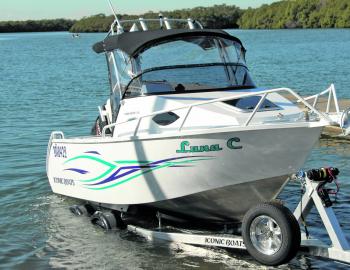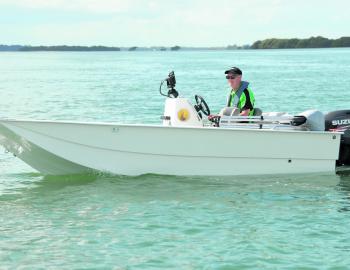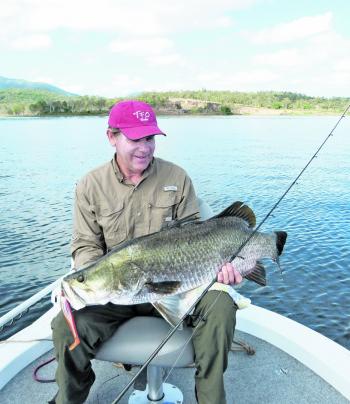Boat selection sounds simple enough, although it would take pages and pages to cover all the variables involved! Instead, I will confine my comments to cover some of the more important things involved with finding the right fishing boat for the job!
When most people choose a fishing boat, they look at how suitable it is for the kind of fishing they usually do and the places they go, whether it’s smooth water such as impoundments or rivers, the not-quite-so-smooth going estuaries and bays, or far out into the bluewater environment.
Such a diverse range of fishing environments will cover all manner of watercraft, from kayaks to specialised boats set up for far offshore travel, with everything from manual power right up to very serious horsepower involved in their propulsion.
In between there are many options, each specifically tailored to suit the fishing and water conditions that the owner expects to deal with for the majority of his or her fishing (and how many people they expect to have on board). Note that very important word, ‘majority.’ A wise boat owner selects a rig that will be ideal for the majority of the fishing in mind, with or without crew aboard.
These conditions should govern the choice of boat, with perhaps three main criteria to consider in the selection of that elusive right boat for the job.
Firstly, ride quality and sea keeping capability are very important. We go fishing for enjoyment, not for punishment. Nobody wants to be driving a wet boat or one that it so rough riding that it’s a relief to finally get out of the thing at the end of the day.
Water conditions will always vary so much that what might start out to be a lovely calm morning at the boat ramp can turn very nasty when a breeze kicks in and chop develops. This is exactly when ride quality and sea keeping – the ability to handle sea or other water conditions in line with the design parameters of the rig – really come into their own. In essence, it’s the combination of both of these qualities that make a boat great to own.
Freeboard must be adequate for the conditions you expect to encounter. It must also be adequate to cater for what can amount to the worst situation on the day. Clearly, a craft to be used in smooth waters such as rivers and impoundments might not need as much freeboard as one heading out into the bay or over a bar crossing on a regular basis.
It’s smart to remember that we boat owners are notorious for biting off more than we can chew, so to speak, and when things have turned from nice to nasty, a boat that has plenty of freeboard in regard to length will always be an asset. Combining excellent sea keeping and ride quality with ample freeboard is an art form, and most major boat manufacturers have this well in hand these days.
Fishing room is the one element that seems to cause the most teeth gnashing and hand wringing. We all seem to want a fishing boat of just the right size – not too big, not too small – but one question always arises: is there enough fishing room?
Looking again at the broad spectrum of boats available, there’s no question that an open tiller-steer craft has all the fishing room. However, no one is very happy to be out on the bay or offshore (or even on a windswept and choppy impoundment for that matter) in an entirely open boat. Where’s the waterproof gear?
It’s far better to keep the tiller steer jobs for the smooth water, the centre or side console rig for the bay along with rivers and dams, and a full or half cabin craft as the offshore option. Fishing room then comes down to maximum use of the space available, even if it might be a bit of a compromise given the other features aboard the rig. Centre and side consoles take up room, but they provide ample convenience while full or half cabins confine fishing room to the cockpit area aft of the cabin.
With those criteria in mind, it’s pretty obvious that the selection of the right fishing boat – putting aside things such as glass vs alloy and cost issues for now – will come down to ticking as many boxes as possible.
Remember that all boats are a compromise. They always have been and always will be. Anglers live with those compromises and work around them. The clue is to sit down at the desk and make some headings, setting out just what the craft will be mainly used for, and what will be involved in getting it to the chosen fishing location.
Power selection is very important. It’s wise to always select the power needed for the main situations, taking into account the number of people who will usually be aboard the rig, and the sort of fishing in mind. Look at what would make the rig just that little bit better for the selected tasks, and how things can be brought together to make it happen.
Other important criteria to consider are the overall size, trailerability, ease of launching and retrieving along with comfort aboard, both when travelling on the water and when fishing. The end result will hopefully be the ideal combination of all of these things.
The fact is that it’s difficult, but not impossible, to get a one-boat-fits-all craft. Think about the waterways you like to fish, and the different kinds of fishing you like to do. If they aren’t drastically different, you’re sweet. If not, you’ll have to make concessions. Common sense dictates that an extra fast, low-freeboard bass boat that can scoot to the far corner of most of our impoundments within minutes won’t be much use heading out through the Southport Seaway on a sloppy day with a bit of swell about. Likewise, a fabulous 7m offshore rig will be a pain to use in confined shallow water sections of places like Monduran or Kinchant dams in search of barra.
Still, it might well be possible to combine freeboard, excellent sea keeping, ride quality and fishing room in one craft suited to a wide variety of fishing pursuits, if you go about things correctly. Next month we will take a closer look at ways of going about this.
Reads: 3653
The Iconic 5.5m is a fabulous offshore or wide bay rig but would be hard to justify in the stealthy corners of a barra dam.

Tailored Marine’s half cabin rig would be just the ticket for offshore work with fishing confined to the cockpit’s work area.

Light weight, easy performance from the Suzuki and room for a couple to fish in comfort makes the Cross Country ideal for rivers, lakes and the like.

A lot of impoundment barra are taken from small boats, where low profile craft are in their element.




